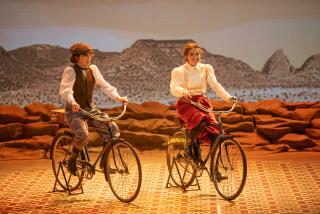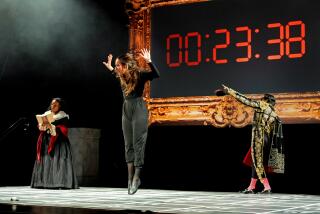With David Bennett in charge, San Diego Opera may get a bit wild -- but not crazy
It’s not exactly a secret, but you get the feeling it wasn’t something David Bennett advertised when he was executive director of the unconventional Gotham Chamber Opera.
“I’m really looking forward to getting my hands on a ‘Carmen’ or a ‘Figaro’ or a ‘Ariadne,’ those kinds of things,” said Bennett, the San Diego Opera’s new general director, who brings with him a deserved reputation for doing very new, and very old, operas in alternative spaces.
His enthusiasm for the standard repertoire has to be reassuring to the San Diego Opera faithful.
They played their role in the opera’s resurrection, stepping forward with others in the community to give millions of dollars in support of an unprecedented crowd-funding effort that unequivocally demonstrated that San Diego wants an opera company.
ESSENTIAL ARTS & CULTURE NEWSLETTER >> Get great stories delivered to your inbox
And the board did its part, providing additional financial support and, as importantly, reshaping the company’s goals and mission to make it more inclusive, more community-focused and more open to a broader conception of opera.
Now it’s Bennett’s turn.
The community and the board still have critical roles to carry out, but Bennett is charged with fulfilling their aspirations.
Under his leadership, the San Diego Opera will undoubtedly broaden its offerings to include chamber opera, concert opera, musical theater and other forms in which drama is communicated through singing, and the company expects to diversify beyond the Civic Theatre.
What’s the exact balance?
Bennett has already started a process of meeting with community members and other arts leaders to get a sense of what could work.
“Our task here is to investigate what’s the right mix,” Bennett told the opera’s association members at the company’s late-June annual meeting, just two weeks into his tenure. “And [to find] what’s appropriate for San Diego that can preserve our existing audience and at the same time engage other parts of the community that aren’t being fully embraced.”
New definitions
In the lexicon of the opera’s former leaders, “chamber opera” were naughty words: an admission of defeat or worse.
It was consistently dismissed as a watered-down version of the real thing, with reduced casts, chorus, orchestra and sets. As Bennett’s predecessor, Ian Campbell, repeatedly mused aloud: Who is going to accept a pale imitation when they are used to the real thing?
That’s arguably one definition of chamber opera, but it isn’t Bennett’s.
Gotham Chamber Opera’s mission was to present works specifically written for more intimate spaces and often presented them in alternative venues rather than traditional theaters.
“At Gotham, we didn’t set out to say, ‘Let’s produce opera in nontraditional spaces to be different,’” Bennett said. Nor did Gotham dedicate itself to chamber opera to save money.
“It’s all about illuminating the work,” Bennett said. “We asked ourselves, ‘If we put this work somewhere besides a traditional theater, will it really bring something to it?’
“That’s was always our starting point: How can putting an opera in nontraditional spaces really elevate the experience?”
So for a work like Daniel Catán’s 1983 “Rappaccini’s Daughter,” which is set in a garden, Gotham Opera offered a production in a real garden in collaboration with the Brooklyn Botanic Garden.
Gotham couldn’t send Haydn’s 1750 “Il mondo della luna” (The World on the Moon) into outer space, but it did the next best thing. Gotham produced the rarely performed opera at the planetarium in New York’s American Museum of Natural History, which partnered with Gotham on the work.
“At least in New York,” Bennett said, “those were the things that became must-see events.”
In Bennett’s definition of “chamber opera,” the forces aren’t scaled down or compromised; it’s just the opposite. Works intended for smaller spaces than the cavernous opera houses constructed as places of worship for 19th and early 20th century opera lovers are not watered down by being performed in a massive auditorium.
But works scaled for a big hall, like “Aida” or “Carmen,” will remain at the Civic Theatre, although they may look and sound a little different.
“We’ll continue to produce grand opera at the Civic Theatre, but instead of doing all of what we do there, we’ll do some there and we’ll do some surprising things in other spaces,” Bennett said. “I think some of what we do at the Civic Theatre may look surprising as well, because it might be a little different from what we’ve done before.
“I’m not advocating everything being a modern vision of traditional opera by any means, but I’m thinking of younger casts, American casts, younger designers, directors, those sorts of things.”
Renewed purpose
Opera was an acquired taste for Bennett, who grew up in Kansas City, Mo., in a musical household. He played multiple instruments before finding his voice and discovering he had a talent for musical theater while in high school. At Texas Christian University, he majored in music history and literature with aspirations of becoming a music critic, but he couldn’t stop singing and found himself succumbing to the appeal of opera.
“The primacy of opera is always the voice and what an expressive vocal line can do to you when you hear it,” he said. “And that sort of the exultation of text through that expressive line, that’s where it started for me.”
The next thing he knew he was an opera singer, performing secondary roles for regional opera companies such as the Florentine Opera in Milwaukee, but he didn’t like the constant travel and found it frustrating to try to sustain a career from outside of New York.
“Also, I felt there were other skills that I had that I wasn’t really using,” Bennett said. “Because I feel like I’m a good leader.”
After he completed a dual master’s degree program at Southern Methodist University (in arts administration and business administration), an internship at Lincoln Center resulted in a position with Artec Consultants, which eventually took him to Dance New Amsterdam and then Gotham Chamber Opera. Along the way, he learned important lessons about fundraising, programming and the importance of playing well with others, which he expects will become a critical part of the San Diego Opera’s DNA.
“I just had a very productive meeting with Martha [Gilmer] and part of her team at the symphony,” he said of the San Diego symphony chief executive. “I think that because of the fact that there’s new artistic leadership with several organizations here, there are opportunities for collaboration that I don’t think existed before.
“There’s an appetite for collaboration among arts leaders, which is very exciting.”
He’s going to need his colleagues’ cooperation to fulfill his aspirations of producing concert operas (with the San Diego Symphony), chamber opera (potentially with the Old Globe or La Jolla Playhouse) or musical theater (perhaps with San Diego Theatres Inc. or a theater company).
As for grand opera, the three 2016 presentations in the Civic Theatre (“Tosca,” “Madama Butterfly” and “Great Scott”) were of necessity planned long before his arrival, largely by Campbell. Two out of three of the Civic Theatre productions for 2017 are in place (the season will be spread throughout the year for the first time), and Bennett’s excited about filling that third spot: At this point it’s a dream, but one possibility is a co-production with Opera Philadelphia of a new “Marriage of Figaro.”
“So for those people who are worried, is San Diego Opera going to turn into some kind of experimental opera company, that’s not going to happen,” Bennett said.
“As much as I love that, I also love standard rep.”
More to Read
The biggest entertainment stories
Get our big stories about Hollywood, film, television, music, arts, culture and more right in your inbox as soon as they publish.
You may occasionally receive promotional content from the Los Angeles Times.






